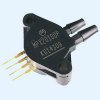Hello All!
A few years ago I was working on a weather station as a school project, I was going to add a pressure sensor as a bonus but never got around to it, but I did order a sample from Freescale before hand.
The sensors is the MPX5999D
Datasheet **broken link removed**
Anyways, turns out I ordered the wrong free sample, I ordered a differential pressure sensor. Now I want to use it as an absolute pressure sensor to measure water pressure for a backup pump system, so if the pressure drops below a certain level, the primary pump will be turned off and the backup pump will kick in, if the backup can't get the pressure back up, it will set off an alarm.
So my question is this, if I seal the back hole with epoxy (the reference port), put an oring around where the front sensor hole is to have an area that will flex, then fit the sensor inside some heat shrink tubing, shrink the tube around it, then fill the top and bottom with epoxy so it is sealed. Do you think this will work?
Here is what I am thinking of doing.
**broken link removed**
A few years ago I was working on a weather station as a school project, I was going to add a pressure sensor as a bonus but never got around to it, but I did order a sample from Freescale before hand.
The sensors is the MPX5999D
Datasheet **broken link removed**
Anyways, turns out I ordered the wrong free sample, I ordered a differential pressure sensor. Now I want to use it as an absolute pressure sensor to measure water pressure for a backup pump system, so if the pressure drops below a certain level, the primary pump will be turned off and the backup pump will kick in, if the backup can't get the pressure back up, it will set off an alarm.
So my question is this, if I seal the back hole with epoxy (the reference port), put an oring around where the front sensor hole is to have an area that will flex, then fit the sensor inside some heat shrink tubing, shrink the tube around it, then fill the top and bottom with epoxy so it is sealed. Do you think this will work?
Here is what I am thinking of doing.
**broken link removed**

